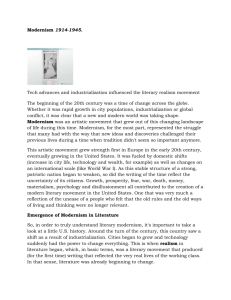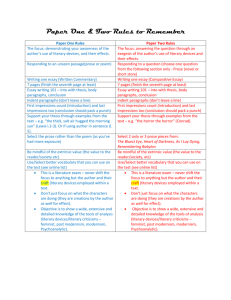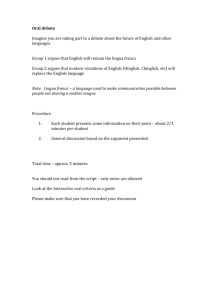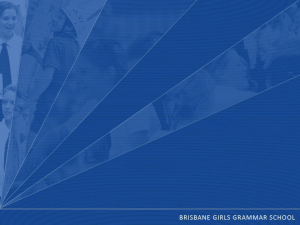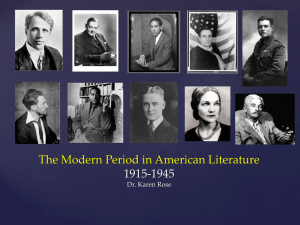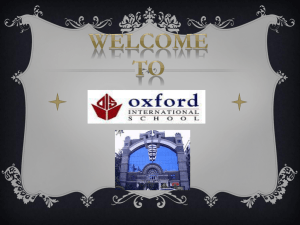Modernism and Postmodernism *Please note that the following is an
advertisement
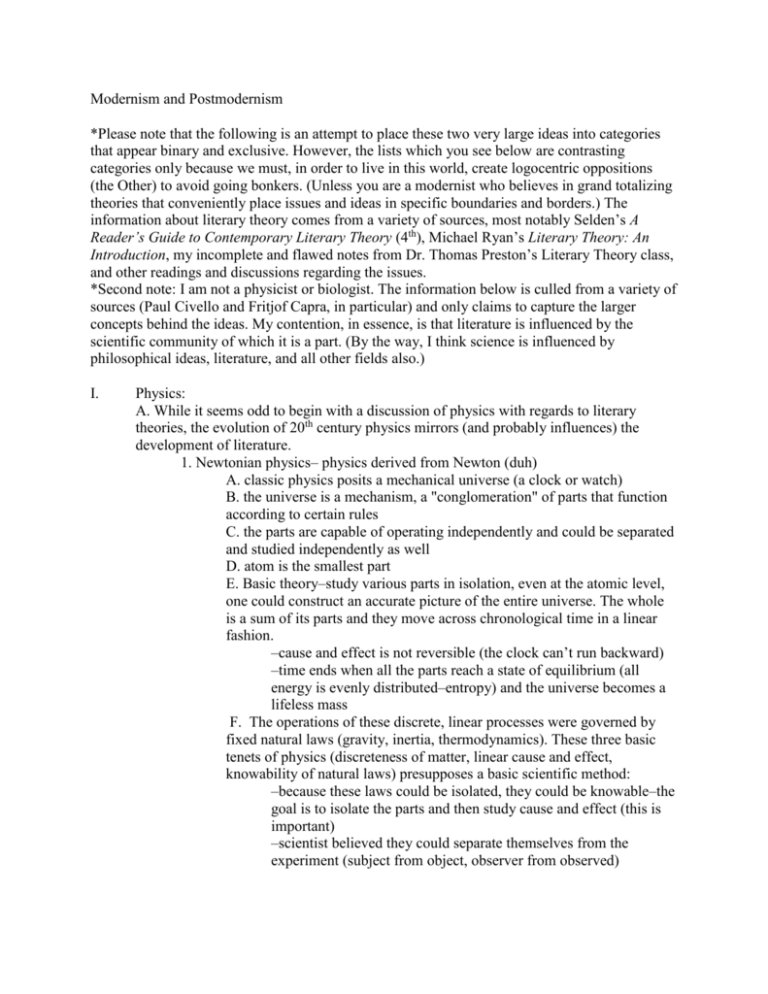
Modernism and Postmodernism *Please note that the following is an attempt to place these two very large ideas into categories that appear binary and exclusive. However, the lists which you see below are contrasting categories only because we must, in order to live in this world, create logocentric oppositions (the Other) to avoid going bonkers. (Unless you are a modernist who believes in grand totalizing theories that conveniently place issues and ideas in specific boundaries and borders.) The information about literary theory comes from a variety of sources, most notably Selden’s A Reader’s Guide to Contemporary Literary Theory (4th), Michael Ryan’s Literary Theory: An Introduction, my incomplete and flawed notes from Dr. Thomas Preston’s Literary Theory class, and other readings and discussions regarding the issues. *Second note: I am not a physicist or biologist. The information below is culled from a variety of sources (Paul Civello and Fritjof Capra, in particular) and only claims to capture the larger concepts behind the ideas. My contention, in essence, is that literature is influenced by the scientific community of which it is a part. (By the way, I think science is influenced by philosophical ideas, literature, and all other fields also.) I. Physics: A. While it seems odd to begin with a discussion of physics with regards to literary theories, the evolution of 20th century physics mirrors (and probably influences) the development of literature. 1. Newtonian physics– physics derived from Newton (duh) A. classic physics posits a mechanical universe (a clock or watch) B. the universe is a mechanism, a "conglomeration" of parts that function according to certain rules C. the parts are capable of operating independently and could be separated and studied independently as well D. atom is the smallest part E. Basic theory–study various parts in isolation, even at the atomic level, one could construct an accurate picture of the entire universe. The whole is a sum of its parts and they move across chronological time in a linear fashion. –cause and effect is not reversible (the clock can’t run backward) –time ends when all the parts reach a state of equilibrium (all energy is evenly distributed–entropy) and the universe becomes a lifeless mass F. The operations of these discrete, linear processes were governed by fixed natural laws (gravity, inertia, thermodynamics). These three basic tenets of physics (discreteness of matter, linear cause and effect, knowability of natural laws) presupposes a basic scientific method: –because these laws could be isolated, they could be knowable–the goal is to isolate the parts and then study cause and effect (this is important) –scientist believed they could separate themselves from the experiment (subject from object, observer from observed) G. This physics effects storytellers (linear stories with a clear beginning, middle, and end) and those who study stories (pull out symbols, study symbol, plug symbol back into story to draw conclusions and all symbols or myths share the same truth–a spring is always a symbol for . . . or write a novel about one man/woman and draw universal truths about the human condition) –Joseph Le Conte’s theories influence Norris and Zola–Le Conte argues that species are continually evolving toward higher forms– no species ever devolves, thus there is a linear progression that benefits all of mankind 2. New Physics: –Fritjof Capra writes: "The two basic theories of modern physics have thus transcended the principal aspects of the Cartesian world and of Newtonian physics. Quantum theory has shown that subatomic particles are not isolated grains of matter but are probability patterns, interconnections in an inseparable cosmic web that includes the human observer and her consciousness. Relativity theory has made the cosmic web come alive, so to speak, bu revealing its intrinsically dynamic characteristics by showing that its activity is the very essence of its being. In modern physics, the image of the universe as a machine has been transcended by a view it as one indivisible, dynamic whole whose parts are essentially interrelated and can be understood only as patterns of a cosmic process. At the subatomic level the interrelations and interactions between the parts of the whole are more fundamental than the parts themselves. There is motion but there are, ultimately no moving objects; there is activity but there are no actors; there are no dancers, there is only the dance." –Specifically, Godel’s Incompleteness theory, Einstein’s Relativity theory, and quantum mechanics play a major role in undercutting Newtonian physics –each argues, essentially, that the universe is an all encompassing field where parts can not be detached and be expected to react the same as they do when in a group. –there is no linear cause and effect–instead there is a mutual reciprocal interaction between events –each is both a cause and effect (physical reactions move two ways simultaneously) –Implicit–observer can no longer be discrete from observed, subject no longer separated from object, audience no longer separate from writer/art work –we are involved in what we describe: Civello writes: "This inseparability of subject and object in the field concept goes hand in hand with perhaps the most significant epistemological shift brought about by the new physics: the shift from Newtonian certainty and knowability to uncertainty and indeterminancy. Godel’s Incompleteness Theorem is of course seminal here–it is often referred to as the indeterminancy principle–for he demonstrated mathematically that indeterminacy was inevitable that one could never prove a theory that was not false was completely true." –Einstein–conceptualizes notion of interconnected field that contained observer (objectivity impossible) –Quantum theory– (Planck, Bohr, Heisenberg) –Planck–light does not behave like the electromagnetic was "it was thought to be" –instead, behaved like energy particles (quanta) –Bohr–probability wave–electromagnetic waves not real waves but indicators of probability that a light quantum was present. –Basically uncertainty superceded certainty –Heisenberg–mathematical formula proving that impossibility of locating position and velocity of particle demonstrates limitations of Newtonian physics–our knowledge can only be partial, probable, guesses –the act of observing is part of the experiment because we observe what be expect and what we expect depends greatly on our theoretical perspective 3. Systems Theory (biology): –developing parallel to quantum mechanics Ludwig von Bertalanffy–argues biology should not focus solely on the molecular level –argues that a biological system "was not a loose collection, but a complex organization of many interrelated and interdependent systems"–when you separate the parts, they behave differently. –closed and open systems are physics systems: Closed systems–(2nd law of thermodynamics)–universe move toward maximum disorder (entropy) and a state of equilibrium (all energy dispersed evenly) –Open system–living systems interact with the environment to continually build up and break down components, moving toward a complex organization –Bertalanffy attacks the linear paradigm in history and psychology, arguing that man "is not a passive receiver of stimuli coming from an external world" –people create as well as are created, determine as well as are determined –history–great people are triggers not causes of historical event– make and made –attacked humanity’s application of science paradigm (closed system) to its interactions with the environment and self –this paradigm (the enlightenment, Newtonian paradigm) threatens to destroy the world by glorifying technology (assumes human scientific ability will evolve to solve problems and is always forward thinking) 4. These two sciences undermine the naturalistic novel and the modernist belief in creating a fiction that can re-center the world. But they also deny the postmodern decentered approach These movements take us away from a centralized truth and destroy the subject/object dichotomy in the 20th century novel. The modern idea is that one must perceive an external truth, grasp it objectively, and we gain insight. The new sciences present the self with a new dilemma: how to locate the subjective self in and reconcile it to a world in which there is not distinction between subject and object. II. Modernism: A. a group of characteristics that emerge at a particular time in Western literature. I would argue, too, that modernism and pomo become the first truly world literary movements. Specifically, though, American modernism (and British to a degree) grow as a reaction against Romanticism, Realism, and Naturalism. We will get to some specifics in a minute, but we want to set the historical stage first: 1. Freud, Jung, Darwin, Marx, Dalton (atomic theory), Mendeleyev (periodic table), and other philosophic, scientific leaders create a climate where the old truths just won’t do anymore 2. Explosion of churches: there’s a new religion on every street corner and the church fragments (a process starting when Gilgamesh rejects Ishtar, but that is another class) 3. Why is the church fragmenting? Time, money, and war –clocks change who control time–a bigger idea than you might think –money–Western culture is now an economic culture and not barter controlled. Marx will show us quite convincingly that losing one’s labor power will lead to alienation and despair (as well as a lack of power). This condition leads to very wealthy segments of the population (who all go to church) who have lavish parties while people starve to death out the front door. –war–look at a timeline–in America alone starting with the Civil War: the indian wars, the Spanish American war, the Mexican Revolution, World War I–what is most notable, of course, is that WWI was fought by two christian nations killing each other for god and country. –archeology merits some mention here too–biblical research is beginning to call into question "the true’ events of the bible. –urbanization–related to money–the agricultural demise has forced millions of people into the cities, creating a huge workforce. Too many people and not enough jobs is a gold mine to corporate owners who keep wages artificially low, forcing men, women, and children to work for 9 cents a day (almost enough to eat on). A work week is 60-70 hours and it’s easy to fire folks. The company owners: good christian men who crushed strikes with bloodshed (and govt. help). –you can imagine the alienation, despair, and loss this causes. These three ideas are keys to the modern sensibility–modern man suffers from an angst ridden existence in which he feels un-moored by the events within his life. The world is fragmented and truth seems elusive. The church is flawed, the govt. can not provide, and even science does not have the answers (see the atomic bomb being created and thousands dying from flu epidemics world wide) This social situation shows up in art. –The following list provides some insight into the central ideas of the modern artists’ aesthetic goals (source for quoted information Martin Irvine <ww.georgetown.edu/irvinemj/technoculture/pomo.html> : 1. “Master Narratives and Metanarratives of history, culture and national identity; myths of cultural and ethnic origin.” This ideas spurs the idea of books like “The Literary History of the United States” and other books that decide what events merit historical, scientific, philosophical, literary recording, creating an archive that represents the “true” story or canon. 2. “Faith in "Grand Theory" (totalizing explanations in history, science and culture) to represent all knowledge and explain everything.” A universal Truth (the big circle with a center that we must maintain). Artists have a special insight into this Truth. 3. “Faith in, and myths of, social and cultural unity, hierarchies of social-class and ethnic/national values, seemingly clear bases for unity.” Anti-hyphenation–this idea spurs the educational system in the early 20th century in America. 4. “Master narrative of progress through science and technology.” Science and technology help us evolve as a people and they are good. 5. “Sense of unified, centered self; ‘individualism,’ unified identity. Idea of ‘the family’ as central unit of social order: model of the middle-class, nuclear family.” 6. “Hierarchy, order, centralized control”–leads to “faith and personal investment in big politics (Nation-State, party).” 7. “Root/Depth tropes. Faith in ‘Depth’ (meaning, value, content, the signified) over ‘Surface’ (appearances, the superficial, the signifier).” The New Critics seize on this idea when reading literature and most teachers still rely heavily on this idea in the classroom. 8. “Faith in the ‘real’ beyond media and representations; authenticity of ‘originals.’” Coupled with #5, this idea argues, in essence, that we have a real self and we should get in touch with it. 9. “Dichotomy of high and low culture (official vs. popular culture); imposed consensus that high or official culture is normative and authoritative.” The creation of the literary canon and, to a certain extent, the creation of professors whose job involves interpreting literature. 11. “Art as unique object and finished work authenticated by artist and validated by agreed upon standards.” See number 1 and 2. The standards are often created after the art, effecting the production of future art. Critics and artists argue for the objectivity of these standards and argue that beauty is something that we can agree upon (within reason) based on the myths of the past. In other words, The Odyssey is a great work of literature that meets certain standards that other works of literature and art contain. These standards become the basis for hermeneutics of presence (what is in the work). 12. “Sense of clear generic boundaries and wholeness (art, music, and literature).” Argues for genre and genre styles. Poems look a certain way and contain certain elements; plays are not poems, therefore they contain different things. 13. “Clear dichotomy between organic and inorganic, human and machine.” 14. “Phallic ordering of sexual difference, unified sexualities, exclusion/bracketing of pornography.” B. Note that the ideas behind modernism, a movement associated with people like T.S. Eliot, Ezra Pound, Wallace Stevens, Marianne Moore, Faulkner, Ellen Glasgow, Hemingway, and all those other writers and artists who begin producing from 19141940s, spawns other artistic movements within this idea (cubism, imagism, vorticism, etc.). –For more information, you should read about the New Critics in literary theory. These men (and they were mostly anglo men) created the American canon and were, in large part, responsible for establishing the aesthetic principles that drove the creation of artistic standards. III. Postmodernism: A. A movement that begins officially after WWII, but there is no real agreement about when. The problem, as we will see, is that post-modernists see all literature as postmodern and would argue that it has always been so. To discuss pomo, we will need to necessarily discuss linguistics a bit. Please note that some of what follows also influences modernism and the ideas associated with it. As a sort of foreshadowing (because you are all in suspense), modernists and postmodernist do not disagree on all ideas. To a certain extent, they both believe the world is fragmented; however, the modernists believe we should (and can) return to a central Truth. The pomodernist, on the other hand, enjoys the fragmentation and sees it as an inevitable outgrowth of language (as we will see). We should also see the real connections to the new physics. Postmodernism, like modernism, is a large idea that we throw around in many ways. More than any other movement, though, pomo is a word used generically to indicate many types of movements. Additionally, many movements are often modernist in certain ways, but they are a product of a postmodern world. In essence, the term postmodernism includes the literary theory of the second half of the 20th century. Meaning for the post-modernists is historicized and contextualized, constantly re-evaluated, and recognizes that the binary opposition of meaning is just as important to meaning. B. Language development and theory: 1. Structuralism (in very general terms): –Saussare gives us the signifier/signified (remember class notes) –basically the signifiers have meaning within a system, i.e. Mustang/car (system–discussion about vehicles) –the goal, Saussare argues, is to always locate the system that creates meaning for the language used. In other words, in literature, locate the symbol system within which the author was working. –Genette criticizes S. by arguing that we do not create and read by locating the present system. Instead, we read by eliminating the other systems (what system is not used–or what definition does not fit) –Both systems are flawed by they do not recognize the historical complexities that blur system boundaries. Each signifier has an endless chain of signifieds based on an infinite # of signifying systems that change continuously. In other words, how do I know what system I am using right now to create these words, and how do I know what system you are using to interpret them. Additionally, if you read these notes before you happen to pick up Saussare or Derrida, they will exist within a different system. 2. Self-conscious language use–these ideas (and ideas like them) create an increasingly self-conscious language use among artists (and individuals who read about these theories). They ask us to consider not only what language system we are working within, but Genette asks us to consider why we are eliminating other systems and words. Think about why I am using the above language instead of all the other choices. Why, for instance, did I chose a mustang as an example? In my hand-written notes I use mother as the signifier and cookie as the signified. Why the change? Was I hungry before? The net effect of this self-consciousness is an awareness that all is text–all activities create signifying systems by which we read other symbols. (Symbols are the key, of course. When we choose to write dog, we are using three symbols to convey an idea. We have not produced the object itself. In essence, I had an idea of dogness; I created some symbols to communicate that idea. You have read those symbols and interpreted them. Perhaps you will write those symbols down. The idea has now traveled from between my ears, to my fingers, to your eyes (or ears if I were lecturing) to your head, where you have created an image of dogness. Dog is many times removed from the reality that started in my head. Of course my reality is influenced by the cultural moment that exists right now and by my personal history of anti-dog sentiment. If you are a dog lover, your idea and subsequent initial idea of dogness is different from mine. This all assumes a symbol system that agrees we are talking about an animal of some sort and not a hotdog, or a slow car.) 3. Think back to modernists/New Critics–for them, literature is a group of words that artists use to create reality. There is a system within the poem/novel we must privilege. We use that system to determine meaning via symbols and myths already established. However, if symbol systems can change (as Saussare will admit) then meaning can change. Genette’s idea of cancellation forces us to acknowledge that artistic choice is not a way to control reader choice (because we are absenting our own set of systems). 4. Wittgenstein– rejects Saussare and Genette by arguing that language acquires meaning based on function and context. Language is a game; words are tools with countless uses (imagine you are trying to put a nail in the wall, but your hammer is lost. You have a wrench. Take the wrench and knock that nail in. The meaning of the wrench is not constant and unyielding. Neither is language.) W. is a post structuralist moving control of language away from the elitist control (professors and works) by arguing (eventually) that reading and writing are functions of language use. (As a brief note: certainly post structuralist and post modernists differ, but these are notes designed to paint with a broad stroke.) 5. Bakhtin: Bakhtin sees all utterance as a struggle for power. All interpretation is contested, and every word in the public domain implies dialogue and contested interpretation. Heteroglossia means “different tongues” or “different speech.” For Bakhtin, the novel is dialogic–the utterer takes account of the possible reply of an addressee so there are always at least two voices in a novel. A monologic text is one in which the utterer and utterance do not take into account the possible reply of an addressee. “Moral freedom is owning one’s own utterances, and the most basic unit of mature democratic culture is an exchange.” “The importance of struggling with another’s discourse, its influence in the history of an individual coming to ideological consciousness, is enormous. One’s own discourse and one’s own voice, although born of another or dynamically stimulated by another, will sooner or later begin to liberate themselves from the authority of the other’s discourse. The process is made more complex by the fact that a variety of alien voices enter into the struggle for influence within an individual’s consciousness (just as they struggle with another in surrounding social reality.” is the contest that recognizes languages’ contamination. 6. Foucault: knowledge is about power. Our idea of truth is dependent not on insight but on the power structure that accepts truth. In other words, Foucault argues that an idea is only true if it fits our accepted idea of truth laid down by political leaders and intellectual authorities. From this idea, we create the normalizing gaze: Foucault argues that the power systems create a rhetoric of appropriate action and language. When you move outside that rhetoric, society condemns you as crazy. He was interested in changing those institutions. 8. Roland Barthes–the author is a location that stores information then repeats it. The reader can enter the text anywhere he/she wants and can attach any signifying system he/she wants to attach. Our pleasure is caused by the readings beyond the general pleasure of the text, and we can ignore the signifiers/structure created by the author (a privileged figure for the new critics/structuralists). What we don’t read, Barthes argues, gives us the greatest pleasure. (Barthes tells us that “Reality is a nice place to visit, but you don’t want to live there.”) Importantly, Barthes’ argues that all discourse is fictive. When we read, we see a connection or reference that may or may not include the text. This echo disrupts the text’s linear progression and gives us pleasure. This pleasure is caused by the tension between the two surfaces (text and memory/echo/reference) and, for Barthes this is akin to the erotic pleasure associated with jouissance (the pleasure of the text and the abolishment of repression associated with the orgasm–the tension associated with that moment of pleasure/pain). 9. Kristeva: Family and society regulate our physical and psychic impulses. Dominant ideology must suppress alternate significations (semiotic differences) in favor of homogeneity and cognitive certainty. We must stand together and recognize truth, beauty, etc. as clear, definitive issues. Writing, because it offers multiple significations, is subversive and dangerous. Some feminist critics use Kristeva and Lacanian ideas to discuss the objectification of women as a tool of social control. 10. Lyotard: All thought and meaning is narration. Micro-narratives are more relevant and important than the Grand Narratives of the new critics. 11. Frederick Jameson: Turns our attention to the economics of postmodern life. He argues from a marxist viewpoint, focusing on the production and distribution of art and the control inherent in a world economy that produces oligopolies. He claims that the free market rhetoric is used to discourage the social planning of production, and free choice is effectively limited to selecting standardized good on the basis of superficial differences. Postmodern capitalism encourages mass production and the consumption of quantity over quality. According to John Unsworth, “Seen from this point of view, the consequences of postmodern capitalism for the author is that s/he now competes for survival in an environment that is economically demotic (popular, vulgar) but intellectually hieratic (appropriate to sacred duties or persons). The increasing distance between the popular and the respectable means that although literacy is widespread and many people to still read during their leisure time, the writer who aims for intellectual prestige, formal originality, or artistic merit is likely to have a day job.” 2. Reader Response: what you see is a movement away from controlled reading to a reader response method. The reader becomes involved in the text as an active participant and creator. We no longer simply try to unlock the author’s system; we must be conscious of our own system. 1. Derrida–logocentrism creates problems –deconstruction–notes a hierarchy, proceeds to reverse it and finally resists the assertion of a new hierarchy by displacing the second term from its position of authority also. Important to note: goal of deconstruction is not to reconstruct (replace one system with another–masculine with feminine). Language, by the very nature of its construction within multiple systems, by someone existing in multiple systems, deconstructs itself and attempts to not privilege any system. All systems (all things) are texts and all texts deconstruct themselves. Everything consists of signs without referents and the only path to meaning is construction of referents that we know will itself be narration and subject to re-vision. (Why the heck are you reading through all of this, then? Haven’t these notes deconstructed themselves by using a system of flawed symbols to discuss the inability of symbols to create meaning?) 2. Linda Hutcheon’s work deserves more attention at some time in your life. This weekend perhaps in your free time. 3. Social effects: readers are valued as something to study. We listen to your response to a poem and then study your response as text (which would lead to a study of your study and a study of our study). All is text–movement, clothes, menus, newspapers–why do we choose certain words, clothes, meals? 4. Ontology: In essence, post-modern thought argues for the importance of ontological discussions. Derrida tells us that words related to “fundamental” values and truths imply a presence. In any given situation, we have accepted behaviors that are logocentrically defined and imply a presence (someone who will tell you that you have violated that definition) who will enforce a particular signifer. Derrida and post-modernists want to decenter (separate) that presence from meaning. The refusal to admit that presence exists is logocentric (language centered). Hence, when we say language is power, we state a clear truth about society, but it is a truth not based on the power of language, but the power of the implied presence who enforces power. Derrida (and others) point out that language is not steady and stable and does not really provide access to some central Truth. Truth is created by those in power who enforce control over language and get to decide who uses it well and who does not. Marxists, feminists, etc. see that power in the hands of white middle class males who have power and who have created a list of qualities that define “universal ideas.” (See above list associated with Modernism.) Ask yourself why rationality is more important than emotion, form more important than formlessness? 5. The following list (a concession to modernist requirements for order via language) is a companion to the list for modernism. Taken from the same web site, it works as a nice companion to all the notes above. 1. “Suspicion and rejection of Master Narratives; local narratives, ironic deconstruction of master narratives: counter-myths of origin.” This idea will lead to an explosion of alternative privileging: Feminist myths, Afro-American, Chicano, etc. In essence, the world opens up and this leads to post-colonial movements in literature and politics. Read Chinua Achebe’s Things Fall Apart. 2. “Rejection of totalizing theories; pursuit of localizing and contingent theories.” All those individual bubbles in the big circle are localized; each has its own system and theory that may or may not be universal and applicable to others. 3. “Social and cultural pluralism, disunity, unclear bases for social/national/ethnic unity.” Multi-culturalism rears its head here arguing for hyphenated expressions. To declare oneself an American is a political decision that carries baggage and argues for a specific political and cultural ideology. 4. “Skepticism of progress, anti-technology reactions, neo-Luddism; new age religions.” Technology is a tool of the man to control the little folk. Think Terminator or Bladerunner. 5. “Sense of fragmentation and decentered self; multiple, conflicting identities.” Ontology. 6. “Alternative family units, alternatives to middle-class marriage model, multiple identities for couplings and childraising.” Argues that the “nuclear family” model is a falsely created and clearly western idea that imposes restrictions on family life. 7. “Subverted order, loss of centralized control, fragmentation.” 8. “Trust and investment in micropolitics, identity politics, local politics, institutional power struggles.” This idea gives rise to the grass roots political, environmental movements. LULAC, NAACP, EarthFirst!, etc. 9. “Rhizome/surface tropes. Attention to play of surfaces, images, signifiers without concern for ‘Depth’.” 10. “Disruption of the dominance of high culture by popular culture; mixing of popular and high cultures, new valuation of pop culture, hybrid cultural forms cancel ‘high’/’low’ categories.” 11. “Art as process, performance, production, intertextuality. Art as recycling of culture authenticated by audience and validated in subcultures sharing identity with the artist.” 12. “Indeterminancy, contingency.” Post modernists are very comfortable not know the answer the world’s problems. Life is to complicated to take a blanket idea and lay it over each incident. No good post-modernist would agree that, in the words of George Bush, “You are either with us or with the terrorists.” Zero tolerance laws are blanket indictments of complicated issues. 13. “Play, irony, challenge to official seriousness, subversion of earnestness.” Some call this cynicism, but a postmodernist would point out language’s inherent flaws and then remind you we are trying to communicate with symbols we don’t understand. 14. “androgyny, queer sexual identities, polymorphous sexuality, mass marketing of pornography the book as sufficient bearer of the word” **Please note that I have oversimplified the issues greatly and the notes above are simply guides. I recommend you take a literary theory class from someone qualified to teach it. At worst, buy a copy of A Reader’s Guide to Literary Theory and slowly make your way through the text. Reading theory does not, contrary to popular opinion, rob the text of its flavor. Theory is a way of reading by recognizing the cultural and historic moments within which art is created. These are notes originally designed for lecture. Hence, there are some ideas and sentences that are here in order to remind me of things to say. Please forgive those incomplete moments. In addition, I have (obviously) used a variety of sources for the information above. I provided bib. information for a couple. The others are lost to time. Do not, in other words, publish anything from these notes because I’m not sure from where I got all this stuff.

